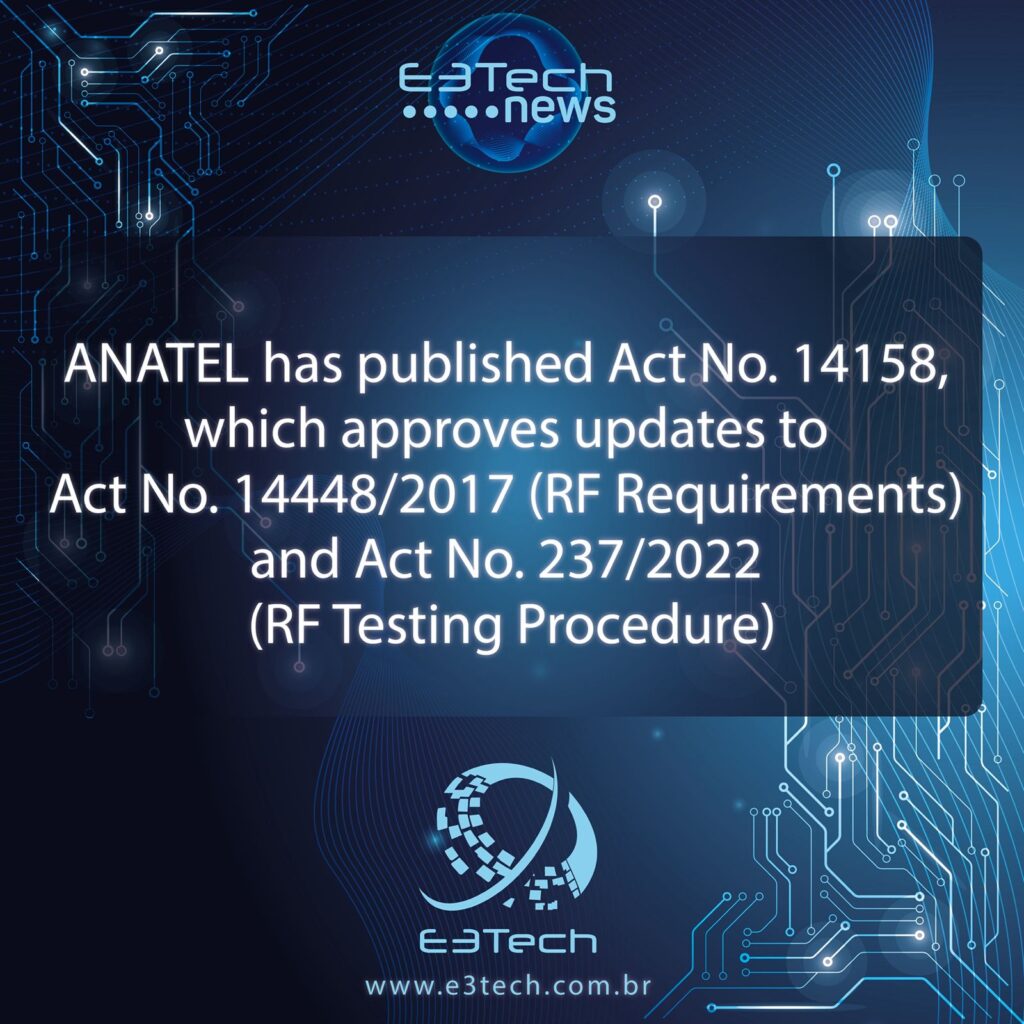E3Tech NEWS
Issue #093 – Regulatory Updates & Technical Insights
ANATEL Act 14158 has been published, introducing several important updates to the Technical Requirements for Radio Frequency Devices originally defined under Act No. 14448/2017 and the Test Procedures under Act No. 237/2022.
ANATEL Act 14158 was published on October 8, 2025, and will become mandatory starting April 6, 2026. Until then, projects may continue to follow the current requirements, but new certifications are encouraged to align with the updated rules as soon as laboratory capacity becomes available.
Key Updates in ANATEL Act 14158:
1. New definition for “Vehicle Radar System (radar veicular)”
A new definition (item 3.1.49) has been added:
“Vehicle radar system: radar installed on land or aquatic transportation vehicles such as cars, trucks, motorcycles, trains, tractors, boats, ships, or any mobile platform designed to transport goods or people.”
2. Wireless Audio Systems (microphones, IEMs, PMSE):
A new item (20.2) defines power limits and test conditions for digital multichannel wireless audio systems, referencing ETSI EN 300 422-1.
→ Impact: Provides harmonized criteria for professional wireless audio systems operating between 54–608 MHz.
3. Radar Systems (76–81 GHz and above):
New provisions regulate the use of vehicle radars and airport-related radars:
- Operation of radars in airport areas and on-ground aircraft is now explicitly allowed;
- Vehicle radars (76–81 GHz) remain covered by their specific technical limits;
4. New Frequency Section – 116 GHz to 246 GHz (Section 25)
A new Section 25 has been created for systems operating between 116–123 GHz, 174.8–182 GHz, 185–190 GHz, and 244–246 GHz.
- Defines EIRP limits (40 dBm average / 43 dBm peak; up to 82 / 85 dBm for fixed outdoor P2P links);
- Establishes measurement bandwidth (RBW = 100 kHz) and spurious limits (≤ 90 pW/cm²) above 40 GHz;
- Prohibits use of these bands on aircraft or satellites.
→ Impact: Opens regulatory access for high-capacity backhaul and fixed mmWave/EHF applications above 100 GHz, with clear emission and safety boundaries.
5. Revisions for the 5 GHz Wi-Fi Bands
The new Act introduces a complete restructuring of the 5 GHz UNII bands, clarifying power and emission limits, creating new sub-items, and aligning the Brazilian requirements with the ETSI and FCC frameworks.
5.1 – 5.150 to 5.250 MHz Band (Item 11.1)
The entire section has been rewritten into four explicit sub-items:
- 11.1.1 – Access Points (APs):
- Conducted power limit: 30 dBm
- Power spectral density: 17 dBm/MHz
- Antenna gain reduction required above 6 dBi
- Additional restriction for Outdoor AP: EIRP ≤ 21 dBm for elevation angles above 30° in outdoor environments
→ Impact: Allow 5.150 to 5.250 MHz band for indoor and outdoor use, adds an explicit limitation for vertical radiation (to protect satellite and aeronautical services), and expresses limits in conducted power instead of total EIRP, affecting lab setups.
- 11.1.2 – Fixed Point-to-Point Links:
- Conducted power: 30 dBm
- Power spectral density: 17 dBm/MHz
- Antenna gain reduction above 23 dBi
→ Impact: Introduces a distinct rule for directional links within 5.150–5.250 MHz, allowing higher-gain antennas before derating.
- 11.1.3 – Client Devices:
- Conducted power: 24 dBm
- Power spectral density: 11 dBm/MHz
- Antenna gain reduction above 6 dBi
→ Impact: Sets clear maximum limits for stations (STAs), preventing over-powered CPEs and improving coexistence in indoor environments.
- 11.1.4 – New requirements for band 5.250 – 5.350 MHz:
- Conducted power: 24 dBm or 11 dBm + 10 log B_MHz, which is the lowest
- Power spectral density: 11 dBm/MHz
- Gain reduction above 6 dBi
→ Impact: Introduces the bandwidth-dependent formula 11 dBm + 10 log B, harmonizing with ETSI EN 301 893. This provides flexibility for narrow- and wide-channel operations (20–160 MHz) but requires recalculation of conducted limits per bandwidth during testing.
5.2 – 5.470 to 5.725 MHz Band (Item 11.3, modified by Art. 7)
- Conducted power: 24 dBm or 11 dBm + 10 log B_MHz, which is the lowest
- Power spectral density: 11 dBm/MHz
- Gain reduction above 6 dBi
→ Impact: Unifies the methodology with the new 11.1.4 formula, changing from fixed 250 mW/EIRP limits to a scalable, bandwidth-based conducted power approach.
5.3 – Additional Clarifications
- Out-of-band and spurious emissions (2.4 GHz and 5.8GHz):
- The conducted power measured in any 100 kHz bandwidth outside the authorized band must be at least 20 dB lower than the maximum power measured in a 100 kHz segment inside the band.
- When measurements are performed using the alternative method described in item 10.3.4, the attenuation requirement becomes 30 dB.
→ Impact: Improves spectral cleanliness and reduces interference to adjacent services. Laboratories must ensure measurement setups explicitly apply the 20 dB / 30 dB attenuation rule depending on the test method used. The change enhances alignment with FCC standard.
- Out-of-band and spurious emissions (5.150–5.350 MHz and 5.470–5.725 MHz): limit confirmed at –27 dBm/MHz EIRP.
- Transmit Power Control (TPC, 11.5): required dynamic range increased from 3 dB to 6 dB (referenced to 30 dBm EIRP); if TPC is not implemented, maximum average EIRP is 27 dBm.
→ Impact: Devices must implement stronger power-adaptation algorithms; older modules limited to 3 dB TPC may require firmware updates or re-assessment.
6. Updates for 57–71 GHz Devices (Article 8 – Item 17 revised)
The section on 57–71 GHz has been completely rewritten, expanding from the previous 57–64 GHz range and modernizing the rules for Field Disturbance Sensors (FDS) and other devices.
- Main limits for FDS:
- Peak conducted power ≤ –10 dBm; peak EIRP ≤ 10 dBm.
- Alternative EIRP limits depending on sub-band and duty-cycle (e.g., up to 30 dBm for outdoor use when off-time ≥ 16.5 ms per 33 ms).
- Specific provisions for pulsed sensors and narrow-band systems, with defined duty-cycle and integration time.
- Other 57–71 GHz devices:
- Mean EIRP ≤ 40 dBm; peak ≤ 43 dBm.
- Conducted peak ≤ 500 mW (or 5 mW × BW_MHz if BW < 100 MHz).
- Spurious and safety conditions:
- Below 40 GHz: standard Table II limits; between 40–200 GHz: ≤ 90 pW/cm² @ 3 m.
- Operation on aircraft allowed only on the ground or in closed in-cabin systems; limited relief for small UAVs (60–64 GHz, ≤ 20 dBm).
→ Impact: Expands permitted use of 60 GHz sensors for gesture, presence, and motion detection; defines precise duty-cycle and power limits; aligns Brazil’s framework with international mmWave regulations.
7. Updates to Test Procedures for 6 GHz Wi-Fi (Article 18 – Amendments to Act 237/2022)
Article 18 revises the text of items 15, 15.1, 15.2 and 15.3 of the Test Procedure (Act 237/2022) to align Brazil’s Wi-Fi 6E/7 testing methodology with FCC guidelines.
- Confirms that testing for the 5.925 – 7.125 GHz band must follow the principles described in FCC KDB 789033 D02, Sections II.A to II.G.
- Reinforces the protection of the 5.850 – 5.925 GHz V2X band, which remains restricted for automotive communications.
- Maintains reference to FCC KDB 987594 D02 for verifying Contention-Based Protocol (CBP) behavior in Wi-Fi 6E/7 devices.
- Updates terminology and structure to match the new methodology introduced by Act 14158 (Articles 6 and 7), ensuring consistent measurement bandwidths and edge-channel evaluation.
→ Impact: Aligns ANATEL’s test procedures with international FCC practice for the 6 GHz band, improves coexistence between Wi-Fi 6E/7 and V2X systems, and provides clearer guidance for laboratory testing and compliance documentation.
Our technical team is available to answer any questions about ANATEL Act 14158 and assist you in assessing whether these changes impact your operations or product certifications in Brazil.
Need more information about ANATEL Act 14158?
View Official Act Email UsFollow us for more news:
www.linkedin.com/company/e3techapprovals/






